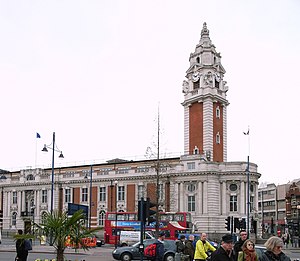Difference between revisions of "Brixton"
From LGBT Archive
Ross Burgess (Talk | contribs) (Created page with "'''Brixton''' is a district in the London Borough of Lambeth, south London, with a shopping centre and well-known street market. It is a very ethnically diverse area, with a ...") |
Ross Burgess (Talk | contribs) |
||
| Line 1: | Line 1: | ||
| − | '''Brixton''' is a district in the London Borough of [[Lambeth]], south London, with a shopping centre and well-known street market. It is a very ethnically diverse area, with a large Afro-Caribbean population. Notable buildings include Lambeth Town Hall, and Brixton Prison. | + | [[File:Lambeth Town Hall.jpg|thumb|Lambeth Town Hall, Brixton]]'''Brixton''' is a district in the London Borough of [[Lambeth]], south London, with a shopping centre and well-known street market. It is a very ethnically diverse area, with a large Afro-Caribbean population. Notable buildings include Lambeth Town Hall, and Brixton Prison. |
In the early 1970s a number of [[GLF]] supporters lived in squats in Brixton. | In the early 1970s a number of [[GLF]] supporters lived in squats in Brixton. | ||
Revision as of 09:33, 19 June 2012
Brixton is a district in the London Borough of Lambeth, south London, with a shopping centre and well-known street market. It is a very ethnically diverse area, with a large Afro-Caribbean population. Notable buildings include Lambeth Town Hall, and Brixton Prison.In the early 1970s a number of GLF supporters lived in squats in Brixton.
In 1999, David Copeland planted a nail bomb in Electric Avenue, directed against the local black community, injuring about 50 people, as part of his hate campaign which also included bombs in Brick Lane (directed against the Asian Community) and the Admiral Duncan, Soho, directed against the gay community.
In 2001, Brian Paddick, then police commander for Lambeth, pioneered a more relaxed attitude to the policing of cannabis possession in Brixton.
